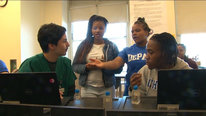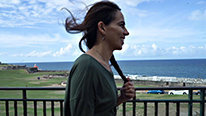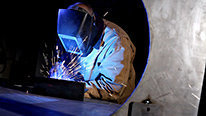- Pei-Ling Hsu
- http://peilinghsu.utep.edu
- Associate Professor
- Transforming Students’ Partnership with Scientists Through Cogenerative Dialogues
- http://workwithascientist.utep.edu
- University of Texas at El Paso
- Yiyu Liao
- Transforming Students’ Partnership with Scientists Through Cogenerative Dialogues
- http://workwithascientist.utep.edu
- University of Texas at El Paso
Public Discussion
Continue the discussion of this presentation on the Multiplex. Go to Multiplex








Pei-Ling Hsu
Associate Professor
Dear Friends,
Thank you for visiting this video – Speak Up! Youth’s Cogenerative Dialogues with Scientists!
My name is Pei-Ling Hsu and I am the principal investigator for this NSF project (2013-2018).
In this project (as known as Work with A Scientist Program), we invited youth to have regular cogenerative dialogue (cogens) with scientists as a way to improve their internship teaching and learning. Cogens are conversations cogenerated by different stakeholders to reflect on participants' experiences and help them reach collective decisions about the rules, roles, and responsibilities that govern their partnerships. In cogens, youth and scientists discussed all types of topics to in order to help them address issues and move forward! Such as teaching methods, teaching pace, group collaborations, critical thinking. In the project, we found that cogens can serve as a useful tool to enrich communication and relationship-building between youth and scientists.
We are also interested in:
Kelsey Edwards
Paul Craig
This is fascinating. Were all of the conversations in person? How long has is been underway? Have you noticed any trends of students being more likely to attend college, or more likely to major in science?
Pei-Ling Hsu
Associate Professor
Hi. Paul,
Yes, these conversations were all in persons. Each cogenerative dialogue (cogen) lasted for about one hour. We had cogens regularly (every week or every other week) throughout the 7 month internship program. This project started at 2013 and ended at 2018.
And yes, we had students coming to us and mentioned that they never thought about attending colleges before but after the program, they would change their minds and would like to pursue colleges now. We also had parents who came to us and mentioned that this program inspired their children to attend colleges/universities.
Pei-Ling
David Campbell
Program Officer (retired)
I'd be interested in knowing how you recruited scientists and what incentives you provided. I would guess that many scientists would be reluctant to participate due to the time commitment. Also, do you think virtual conversations would work for students who do not live near academic or govt. research institutions?
Pei-Ling Hsu
Associate Professor
Hi. David,
These are great questions! There were a lot of planning in the project.
To recruit scientists, we need to communicate carefully about the time commitment and possible significant impacts they would make on the youth. We started by surveying some graduate and undergraduate students to reflect on their science courses and which scientists they think might have intrinsic motivations to make impacts on youths' science learning. Based on these recommendations, we then met with each individual scientist candidate to provide a program introduction, communicate with the work involved, and address their questions. Incentives include salary, assistant, and supply support. But importantly, the rewarding experience they will have when they see the impacts they made on the youth. Our scientists expressed that they enjoyed the cogens with youth and learned interesting insights from youth too about their own scientific research! As a result, youth continued to maintain a good relationship with scientists after the internship program.
For the virtual conversations, I think it is possible! It will be great if we have a platform that is especially designed to have cogenerative dailogues. So respect, equity, different perspectives are valued even in the virtual conversations.
Kelsey Edwards
Mary Murphy
Instructor
As a classroom teacher I have been involved with a few tools/ protocols for encouraging students to discuss and learn from each other. Two examples are productive talk and talk moves, the other is using equity maps (an app). Thinking of these tools, I am interested in knowing if there are tools/ processes/ protocols that you have specifically developed so that students are able to become more and more effective with each other and therefore in communicating with scientists?
Pei-Ling Hsu
Associate Professor
Hi. Mary.
Thank you for sharing these great tools and resources.
In cogens, we have two protocols to follow:
The first protocol is about cogen rules:
The second protocol is about the cogen structure:
These two protocols were designed to hold participants accountable for their talk and actions, importantly, to concertize "respect," "equity", and "value different perspectives" in conversations.
At the beginning, participants might need to discuss and clarify the meanings of these rules and structure and also were reminded of these protocols if they don't follow them. With time goes by, these protocols were embodied in cogen conversation and time with participants.
Kelsey Edwards
I was completely captivated by your video! It's the first animated one I've come across so far and I think it was very very well done (and very cute!). I will definitely be checking out your project.
Trey Smith
Pei-Ling Hsu
Associate Professor
Kelsey, thank you for the comment.
We have a great Academic Technology team here at the University of Texas at El Paso, led by Mr. Steven Varela, who listened carefully and helped our project create this video. We are super grateful for their great work for this STEM showcase. :-)
Mayte Piedra
Congratulations Dr. Hsu! What a wonderful experience and engaging video!
Pei-Ling Hsu
Associate Professor
Thank you, this is indeed a great journey! I am very impressed with youths' courage to speak up and creativity for brainstorming solutions in cogens; also, scientists' openness to accept feedback from youths and willingness to adjust their teaching practices according to their discussions in cogens.
Jacob Grohs
Assistant Professor
Thanks for sharing this very interesting work! I imagine it takes some times for students and scientists to get comfortable with the cogen rules and to really invest deep in the process and that some of this investment ebbed and flowed over time. Can you share some of your experiences with how groups progressed over the 7 months?
Pei-Ling Hsu
Associate Professor
Jacob, that's a great question.
You are right. Students and scientists would need time to get used to the cogen rules and structure, especially they were using their weekends and summer time for the program. That is, they did not know each other beforehand and so how did we help them shape a safe space for cogens, which required them to open their hearts and trust each other to engage in honest and respectful conversations?
We did many things to support their cogens. Here I listed some important principles:
At the beginning, participants might forget about the rules (e.g., someone dominates the conversation). But with several reminders from the cogen mediator and the discussion on the cogen quality each time, participants tend to understand what is cogen and what is NOT cogen. Eventually, participants would make sure to have equal turns, respect others’ talk, and brainstorm solutions to be implemented for the greater good of the whole group.
Joi Spencer
Awesome project! These conversations are so important for students. I look forward to learning more.
Pei-Ling Hsu
Associate Professor
Hi. Joi, yes! You are so right! These conversations are so important for students.
Many students told us that they "finally" met someone who really cares about them and is willing to hear what they have to say. They wish that they have cogens in their classes or in their other after school programs too. Students felt that having cogens solved many of their concerns and questions and built stronger bonding between scientists and themselves.
Jonathan Lewis
Very cool project and fantastic animated presentation. Thanks! I'm encouraged that both the students and the scientists seem to be growing as a result. Is the program continuing? Can it be adopted in cost-effective ways elsewhere? Is that sort of effort underway? Thanks again!
Pei-Ling Hsu
Associate Professor
Jonathan, thank you for your comment. And that's great question!!! We asked this question in our team too!
Currently, we are working on a grant proposal to see how we can create a model to sustain such student-scientist partnerships! The very important thing is to cultivate a culture that values students' voices and team work! Cogens itself is cost-effective and all kinds of creative and collaborative voices in cogens have the potential to help address issues, like cost, resources, areas for improvements in their partnerships among different stakeholders. Thus, how to create that respectful and collaborative culture is the key.
Do you have any other idea or suggestion?
Jonathan Lewis
Going for additional funding support sounds like a good move. I wonder if STEM businesses might help fund such a thing? It seems like a natural means for local business stakeholders to support their own STEM workforce development and at the same time help both researchers and young students (e.g., energy, biotech, AI sectors). Also, a published or shared roadmap might help others to adapt your methods in settings where they have funding streams already in place to support it. It sure seems like a rich area for research (please note I say this as a geoscientist!). Thanks again!
Pei-Ling Hsu
Associate Professor
Jonathan, Yes, these are great ideas. Thank you for sharing your insights.
About the shared roadmap, may I know a little more about what you meant by that?
We might be able to generate these materials and make them available to others.
Jonathan Lewis
I guess I was vague because I don't know exactly what would be most helpful or even appropriate. My sense from the systematic approach you seem to have taken and the concise protocols you describe above is that you might have created a "user manual" to help guide the interactions between the scientists and the students. Sharing these kinds of basic operating procedures might be quite helpful to folks aiming to replicate what you're doing.
Pei-Ling Hsu
Associate Professor
Jonathan, thank you for the clarification and great idea. I have a better understanding now.
I can imagine to create a cogen manual for people to use, which may include information, like cogen rules, cogen structure, frequently discussed topics by youth, frequently discussed topics by scientists, what to do when dialogues get stuck, how to mediate dialogues, what is respect, equity, active listening in cogens, etc.
You are right. Once scientists have a manual like this, they might be more likely to conduct equitable and respectful dialogues with youth. Thank you for this great conversation!
Charlotte Vines
Cogenerative dialogues are a great idea! Ultimately, with time and practice they should occur naturally!
Pei-Ling Hsu
Associate Professor
Dr. Vines! Thank you for your comment! I have to say that you are one of our BEST scientists in the program!!! You have been very caring and passionate in the internship teaching. Thank you for your great work with youth!
Yes, I know sometimes students would say "it is time for a cogen!" or "we should have a cogen on this topic" even though it is not the real time for the scheduled cogen. They seem to use cogen as a tool to solve any issue they encountered, whether it is an individual concern or group concern. Youth tend to pick up the concept of cogens easily and quickly and start to take the responsibility of their learning! Sometimes, youth would talk like a teacher to each other in cogens (e.g., "I think we should work as hard as scientists! Let's not procrastinate any more!". It is exciting to see how youth is taking the leadership and is responsible for their own learning.
Mary Murphy
Instructor
I know many scientists that are working in their field and are willing to share but don't necessarily have the skill set to have dialogue. I think Jonathan Lewis's idea of a road map/ framework/ operating procedures is a good one. I am not sure I would feel comfortable as a classroom teacher being the initiator of offering this road map to scientists that we want to build a cogens with unless it was someone I already had a relationship with. So my question is - If thinking about scaling this to more and more communities of scientists and students....who creates the community? Who entices the scientists into wanting to use this model to support themselves as communicators?
Pei-Ling Hsu
Associate Professor
Hi. Mary, that is a very good and important question.
Myself is a science educator and educational researcher and I am interested in finding ways of enhancing the communications and interactions between scientists and youth. Because I know working with scientists provides SO MUCH for youth, including career aspirations, science interests, knowledge, skills, nature of science, college readiness, self-esteem, etc. It is very important for students to have high quality interactions with scientists.
I am also interested in finding ways to sustain high quality youth-scientist partnerships. Grants are one effective way to initiate a high quality youth-scientists partnership. However, when grants are finished, such partnerships usually would disappear. Thus, I think being able to listen to all stakeholders, address their interests, and find creative ways of using resources would be an important step to create sustainable partnerships.
Another important consideration is to cultivate a culture which values scientists' contributions to the community and society. By promoting broader impacts in each project, NSF already starts to promote the importance of sharing scientists' work with the public. I think what is also important is to cultivate the culture of recognition at the local levels. Thus, scientists' openness to share their scientific research can be recognized fairly and systematically.
Ideally, I think it will be good to have an "education center/hub" in each science community. Thus, whenever a school teacher would like to work with certain scientists, they can reach out to the staff in the education center. or maybe a scientist who would like to share their work to school teachers or students, they can reach out to the education center too. The education center then can serve as a supporting role in facilitating their partnerships.
So to respond to your question, who creates the community? Who entices the scientists into wanting to use this model to support themselves as communicators? I think science educators/researchers (i.e., staff in the education center) might be good candidates because they might be able to understand scientists' interests and teacher/students interests and be able to provide trainings/resources/services required to cultivate good communications and interactions for high quality youth-scientist partnership.
Do you have other suggestions or ideas?
Further posting is closed as the showcase has ended.